Displaying items by tag: WM Nixon
Peggy Bawn Press Launches New Website
#Books - Not content with being Afloat's Sailor of the Month for March this year, boat enthusiast Hal Sisk has put much of his efforts in 2012 into his new publishing venture Peggy Bawn Press, which now has a brand new online presence.
Sisk is commendable for his work both in researching Ireland's seafaring history - making it accessible to less academic mariners - and in restoring ancient boats that provide an insight into the past.
His work on the 1880s clipper Peggy Bawn in particular is a fascinating window into a time of rapid change in design, something he's also made the focus of Peggy Bawn Press with a biography of Scottish boat designer George Lennox Watson by Martin Black - which received a rave review from our own WM Nixon this part March.
And just days ago Tom McSweeney had some kind words to say about Sisk's own new and beautifully illustrated publication Dublin Bay: The Cradle of Yacht Racing, a title he says is sure to provoke debate about Dublin Bay's legacy in the sport.
Both books are available for purchase via the Peggy Bawn Press website, while the latest news on publications can be found on the official Peggy Bawn Press blog.
UCD are Sailors of the Month for November
#ucd – Never before have we had ten Afloat.ie/Irish Independent "Sailors of the Month" in the one month. But with Christmas approaching it's time for gifting all round, and the adjudicators have agreed the entire UCD team that clinched the Student Yachting Worlds in France four weeks ago are Sailors of the Month for November.
UCD Sailing Club Captain Cathal Leigh-Doyle made best use of the extensive resources of talent available in Ireland's largest university by taking along a squad of ten, even though the boats used are actually raced by eight.
Ever since they won the right to represent Ireland by taking the national college title in Dun Laoghaire in March, the UCD club's key officers had been keeping an intensive training programme on track. They'd also copped on to the significant fact that you're allowed to deploy substitutes, massively important when the high-scoring overnight offshore race followed immediately after a day of intense inshore contests.
With the points table at a crucial phase, sailing skipper Aidan MacLaverty and tactician Barry McCartin were able to bring on board the fresh energy of the highly experienced Ben Fusco and Ellen Cahill for the marathon overnight contest, and this made for the key contribution to the massive points lead with which the Irish team clinched the world title.
The complete team were Cathal Leigh-Doyle, Aidan McLaverty, Barry McCartin, Ben Fusco, Ellen Cahill, Simon Doran, Bella Moorehead, Alyson Rumball, Theo Murphy and David Fitzgerald, and they did us proud.
FASTER, FASTER...
Speed is of the essence in global sailing at this time of year, with conditions at their best in the world's favoured location for those extreme extra knots, Walvis Bay in Namibia. Where everyone once dreamed of breaking the 40 knot barrier, and then the 50 knots, now we're looking at 60, and the focus is shifting from kite-sailing back to boats.
Presumably the reason is once a kite surfer get beyond, say, 55 knots, they're not really on the water at all. And anyway, without the protection of some sort of hull, speeds of this nature are highly dangerous – we're pushing towards a hundred kilometres per hour, and at those speeds the sea becomes a very unforgiving surface – you need a boat of some sort around you.
But they're not boats as we know them. When Australian inventor Paul Larsen appeared at the Weymouth Speed Week with his first SailRocket just ten years ago, he struggled to get past 30 knots, but even then his boat was off the wall, more a sail-machine than a boat. Now with SailRocket2 and perfect sailing conditions at Walvis, the veteran speedster has this week been able to claim an officially recognized record of 59.38 knots, and it is known that he has been sailing better than 65 knots.
It's all very well so long as the old engine holds together. But with the new generation of 72ft America's Cup catamarans showing how easy it is to go into widow-making cartwheels when you push the speed up to just 45 knots, these guys have clearly gone beyond being sailors – they're test pilots, and with a Kamikaze flavour too.
Certainly some seasoned observers of the America's Cup scene are seriously worried about the danger the new AC boats pose to life and limb. Most folk assume that with a capsize, you have a soft landing with so much water about. But the reality is that with the oversize dimensions of the new generation of America's Cup cats, if there are any breakages a crewman falling from the outermost part of the stern onto the wing mast can have a direct drop of 35 to 40ft, and if he lands on splintered carbon there's lethal potential for injury.
GALWAY ON THE MARCH
It looks increasingly unlikely that Galway will be a host port for the next edition of the Volvo Ocean Race, with the deadline of December 7th for making a soundly-based proposal looming up while too many issues still remain unresolved from the last time round.
Already in Galway you sense a mood of moving on, and the acclaimed honouring of NUI Galway's Reflex 38 as the ICRA Boat of the Year is a reminder that there is offshore campaigning from Galway in other areas of sailing, and it was very much there - and nationally recognised - before the Volvo circus came along.
At the presentation of the award, the boat's owner Martin Breen – a key player in the "alternative Galway" offshore racing scene – was inspired to assure everyone at the ICRA AGM that, come June, "everything that floats in Galway will be at Fenit for the ICRA Nationals".
And Nobby Reilly, the new ICRA Commodore, fondly recalled those halcyon days when the GK 34 Joggernaut, owned and campaigned out of Galway Bay SC by Donal Morrissey and his team, was a regular and successful performer in a huge variety of offshore events in Ireland and abroad.
What the rest of Ireland may not know is that the Joggernaut team syndicate is still very much in action, operating on two fronts. They have a cruising ketch, the 48ft Rebound, which is kept busy in many cruising areas, and for "a spot of sport at home", they have the Dubois 34 Nowhat, a speedy machine which was very much in the hunt when the team went forth with other Galway Boats to Calves Week in West Cork back in August.
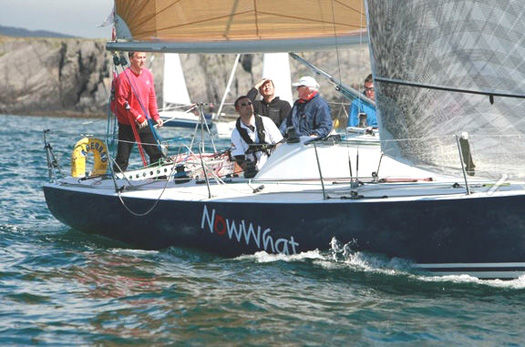
The Joggernauts of Galway are still very much at it – seen at Schull during Calves Week 2012 racing their Dubois 34 Nowhat are (left to right) Barry Heskin, Declan Killilea, Robert McDonagh, Donal Morrissey and Declan Mahon.
NATIONAL 18s COME TO DUBLIN BAY
It was a brilliant move to invite the extraordinary National 18s out of their Crosshaven stronghold to stage their annual championship in Dun Laoghaire at the National YC in the middle of June next year. In the week after the Dun Laoghaire to Dingle Race, and with the offshore brigade in strength at Tralee Bay, the current Mitsubishi Motors "Club of the Year" would otherwise be quiet enough at the time. But everything we know about the National 18s suggests that any risk of an unseasonal easing of the sailing and social pace has now been very effectively blown away.
They're great boats, and great people sailing them. So vigorous is the class spirit in Crosshaven that back in 1994, they inspired the creation of the 1720, which was envisaged as a 26ft keeled version of the National 18. As the boom years arrived, the 1720's demand for a crew of five was difficult to meet, everyone had boats, so the SB3 (now the SB20) was created as a little sister. But with recession upon us, the quite complex SB20 has – at the very least – paused for breath. So now we've come full circle, the focus is back on the National 18 as a three man boat which can function within a manageable budget, and who knows what will come of the class putting in a gallant show in Dun Laoghaire.
Time was – as the item in this website yesterday recalled – when there was a class of National 18s at Skerries. And way back in the 1930s, there were three pioneering boats at Howth trying to inaugurate a class of large dinghies, for this was before the Mermaids started gathering strength.
But the class at Crosshaven was always in a league of its own in terms of vitality, and curiously enough their strongest National 18 links were at the other end of the Cork-Swansea ferry, where there was a thriving class at the Mumbles Sailing Club. The inter-club contests at both centres involving the Royal Munster (as it was then) and the Mumbles were epic. These days, you might be lucky enough to get some venerable and ever so respectable pillar of Cork society to unwind a little as he happily remembers those expeditions to Welsh Wales, and the return visits by the Welshmen complete with their choirs.
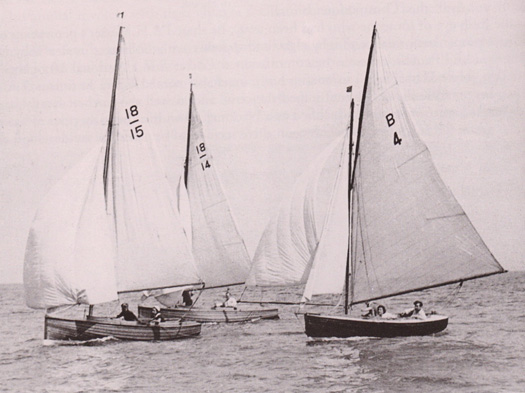
Howth Regatta 1939, with two of the pioneering National 18s of the Uffa Ace design racing with a similarly-sized Essex One Design which had been imported in the hope of establishing a class of large dinghies. The leading National 18 is helmed by Aideen Stokes, while Artie Corbett helms the Essex OD. Photo: W N Stokes
Flying a Kite for the Olympics
#sailing – Kiteboarding anyone? Or perhaps you'd prefer a spot of kitesurfing? They're arguably one and the same thing, and what they're called depends on which part of the world you're doing it in, and the sea state. Whatever, beachwalkers in Ireland will have been well aware of the rapid growth and development of this extreme form of sailing in which athletic ability allied to skill in harnessing the power of the wind is unrivalled in any branch of watersport.
Next month it comes centre stage in Dun Laoghaire when the International Sailing Federation Conference – which is being held in Ireland for the first time – has to consider and confirm the lineup of categories which will be used at the Rio de Janeiro Sailing Olympiad 2016. And one of the most important matters on the agenda is the possible replacement of windsurfing by kiteboarding as an Olympic sport.
For casual beach-walking observers only concerned that they and their dogs don't get caught up in the lethal control lines of the kite sailing brigade, it's a wonder that there is any way at all of evaluating and scoring such an utterly off-the-wall and totally individualistic activity. But not only is it managed somehow, it has been developed to such an extent that there's a world circuit, with professional riders, and the kitesurfers' pro circuit are doing their thing down in Achill and other nearby west coast venues for the next ten days as part of the world series.
Unfortunately, just as it was when the Windsurfer Worlds came to Dungarvan in West Waterford a couple of years ago, after a spell of unpleasant weather things are settling down for a few days to frustrate anyone who has been beating the drum about Ireland being the place for big winds and big-hearted kitefolk.
But the show goes on with international development. For the first time ever, kiteboarding has been included in the most recent listings of the ISAF World Rankings published last week, with Adam Koch (USA) the men's Number One, while Italy's Riccardo Lecesse is second and there's equal third for France's Julien Kerneur and the USA's John Heineken. Steph Bridge of Britain tops the women's rankings, with Caroline Adrien of France in second and the Netherlands' Katja Roose third.
As for the kitesurfing specialists, among those making the scene in Achill and other points west are top names like Patri McLaughlin, Ryan Coote and Keith McGeown, while the women's division sees Ireland's Jade O'Connor gamely challenging world leader Ninja Bichler of Germany.
With any luck, a week hence there'll have been enough wind to get the rest of us up to speed with kites and their Olympic potential. It's all happening very quickly, but the Olympic sailing machine can sometimes move surprisingly swiftly in order to keep up to speed with global trends. Traditional sailors, however, are a conservative bunch. They'll tell you that there are old sailors, and there are bold sailors, but there are no old bold sailors. So it took most sailing folk quite an effort to grasp the fact that Windsurfing had become an "Olympic yachting" activity. Now the old salts may have to readjust their mindsets yet again – goodbye windsurfing, hello kiteboarding?
One noted mainstream sailor who has been trying his hand at kitesurfing is Nin O'Leary of Cork, who ensured his place in the international sailing hall of fame by winning the Student Yachting Worlds for Ireland in France two years ago. The 2012 staging of this important event is now in final preparation in La Rochelle, with racing starting in a week's time and UCD representing Ireland.
In the Mediterranean, the final major event of the 2012 European offshore season, the Middles Sea Race out of Malta, starts today with two Irish boats in the record fleet of 90 boats. The two-handed division is being contested in the JOD 35 Dinah by Barry Hurley, who has already done the race six times crewing other people's boats, while Des Kelliher's First 47.7 Galileo races the fully crewed division.
OLD OLYMPIANS NEVER DIE, THEY'RE ONLY PUT OUT TO GRASS
Is there life for a boat class after the Olympics? It's said that the International Dragon Class (featuring as one of the keelboat classes this weekend at the increasingly popular 'Autumn Fresh-up' at Dromineer on Lough Derg) has never looked back since it was dropped fom the five ring circus – it is now more popular than ever among discerning owners who care as much about their boats and the people they race them against as they do about their sport.
Once upon a time, the Olympic three-man keelboat class was the Soling. It's said that during the 1960s, the Soling was selected in preference to the Etchells 22 for the Olympics because the Scandinavians with their Soling were better at the politics of international sailing, which was very Eurocentric in those days. They ran ran rings around the Americans with their Etchells 22 in the committee rooms, even if the Etchells had run rings round the Soling out on the water.
Be that as it may, the Etchells 22 is now the very epitome of cool on the international one design circuit. But as for the Soling – well, I believe they may have a class still going at a muddy creek in Lancashire where the boats float for about four hours in every 24, but apart from that the Soling in 2012 is making zero impact in the glamour stakes.
So in Port Ellen on the Scottish island of Islay back in August when summer was strong upon the Hebrides and we were gently cruising north, in ambling around the harbour in the sunshine I was intrigued by the hulk of a boat which had been hauled clear of the sea into a beachside meadow.
It took an effort of imagination to visualize the conditions which might have brought this pointy little machine to this sorry yet not totally broken state – after all, she was still sailing along through the long grass in some style, albeit with her rig long gone. Obviously she was some sort of former inshore racer which had been cabined-up in order to become an offshore performance cruiser, but it took a while to realize that here was the final incarnation of an International Soling.
The way she had been converted for offshore sailing was basically sound, even if it would get no marks for design aesthetic. And yes, if you're absolutely mad keen on saving boats which everyone else thinks are lost causes, it's perfectly possible that she could be made seaworthy again at enormous cost in time and money - but there are boats in need of help and restoration which are much more deserving causes.
The little old sea warrior of Port Ellen should be left in peace. She probably had a gallant bash at something like the Round Britain and Ireland Race a very long time ago, or even a Transatlantic. There may even have been a tragedy involved – we didn't ask. But now she has a pleasant resting place with a roll in the hay, and we should respect that.
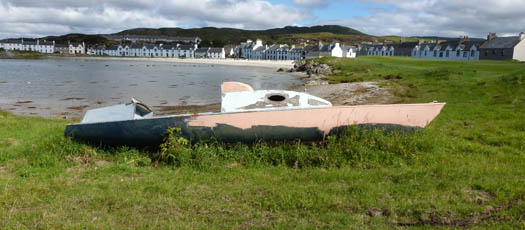
The cabins added later wouldn't have won a design prize, but they were probably quite effective within their limits. Photo: W M Nixon
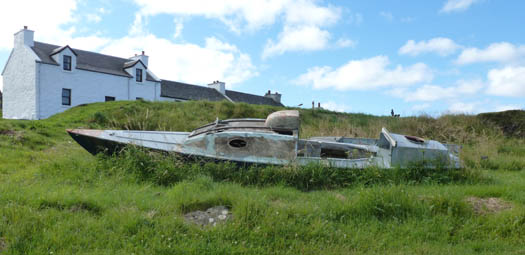
It's an International Olympic Soling in her final incarnation, sleeping in the sun on a Scottish island. Photo: W M Nixon
Round Ireland's Enhanced Status, & Two Centenarians Strut Their Stuff
#sailing – With so many major international events descending on Irish sailing throughout the 2012 season, it's inevitable that our own home grown classics slipped quickly from the headlines. Yet now, as we see the national programme winding down towards the Helmsman's Championship in October, an appraisal of the summer's highlights shows that the Round Ireland Race from Wicklow has enduring significance.
Denis Noonan and his organising team stick doggedly to the task of keeping this 704- mile challenge in place, and in 2012 they achieved a major breakthrough in getting the round Ireland the same points weighting as the Fastnet Race (which is held in alternate years) in the annual RORC programme, which is as near as we get to a Northwest Europe Offshore Championship.
Thanks to this enhanced status, for the first time there were more overseas boats than home grown entries. In the contest for first place, defending round Ireland title holder Piet Vroon from the Netherlands with his superb Ker 46 lost out by just 12 minutes to father and son team Bernard and Laurent Guoy of France with the 39ft Inis Mor.
This resulted in celebration at Jason Ker's design office, as the Guoy machine is a Ker 39, sister-ship of Anthony O'Leary's Antix. And there was celebration in Connemara too, as the Guoy family have a place near Clifden, and they make a point of listing Clifden Boat Club as their requisite club when racing round Ireland.
All of which is fine and dandy, but it's when we look at the bigger picture that the really encouraging factors emerge. The RORC season-long points series recently concluded with a cross-channel overnight sprint from England to France, and the outcome of the championship hung on this final race, with a number of boats which had built their points total on a good round Ireland result well up on the leaderboard.
Going into the race, the title was Inis Mor's to lose, and it was a close-run thing. They did it by the skin of their teeth – a so-so fifth overall was enough to stay ahead of Tonnere – overall winner of this final contest - by just one point.
It made for a specially happy ending. Losing would have been unthinkable – Bernard Gouy celebrated his 69th birthday during the course of the race, embodying the Irish Sailing Association's dictum that sailing is a sport for life.
So now Inis Mor of the Clifden Boat Club is the RORC's Yacht of the Year, and already leading campaigners will be setting the 2014 Round Ireland Race at the heart of their programme. Meanwhile, other boats which showed well in the Round Ireland have spent the remainder of the 2012 season battling it out in the Irish Sea programme, and one of the top contenders, Stephen Tudor's J/109 Sgrech from Pwllheli, is the new ISORA champion, taking a title which should have been defended by Matt Davis's Sigma 400 Raging Bull from Skerries.
Unfortunately, the Bull broke from her moorings and came ashore on Skerries strand in a northeast gale back in May. Miraculously, this popular boat didn't become a total loss, but she was out of racing for the rest of the summer. Maybe some day there'll be a proper harbour at Skerries, enabling the Fingal port to take its rightful place as a leading Irish sailing centre.
THE MERMAIDS' GRANNY AND THE OLD LIGHTSHIP
Despite the decidedly rumbly anchorage at Skerries, for one Irish class it's something of a Mecca, and in August the Mermaids naturally gravitated to Skerries for a week of racing to celebrate their 80th Anniversary. Skerries always held a special place in the heart of the Mermaid's creator John B Kearney, something which is celebrated by the spectacular photo in the National YC of his most famous cruising yacht, the 38ft yawl Mavis, sweeping in to the finish of a Skerries regatta in the 1940s with Skipper Kearney – an outstandingly successful racing helm – in happy command.
Before he designed and built Mavis in 1923-25, he built the 36ft Ainmara in 1910-12 in just 18 months in his spare time, and as Mavis is now in America, Ainmara has become the flagship of the Kearney fleet in Ireland, the Mermaids' Granny.
By a happy chance, the lightship Petrel, the HQ of the Down Cruising Club in Strangford Lough, was also built in 1912, being completed on the north side of the Liffey while Ainmara was being created in Ringsend. For both vessels to have reached their Centenary is wellnigh miraculous and definitely worthy of celebration, so last weekend Brian Law, President of the Down Cruising Club, hosted two days of parties to mark the occasion.
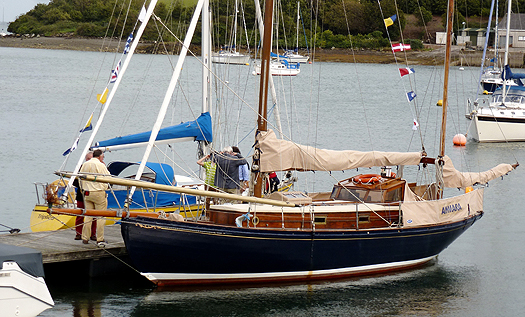
The Mermaids' Granny – owner Dickie Gomes has Ainmara looking very trim for her hundredth birthday. Photo: WM Nixon
Ainmara has featured here in recent weeks as we did a Centenary Cruise to the Outer Hebrides in August with longtime owner Dickie Gomes, but the story of Petrel deserves to be more widely known. Back in the 1960s the nucleus of the Down Cruising Club was a few like-minded can-do cruising boat owners who needed some sort of base at Ballydorn in the northwest of Strangford Lough, and they put in a sealed offer with the Commissioners of Irish Lights for a recently decommissioned 1912-built lightship.
But they were outbid by Dublin's Hammond Lane Foundry, who saw the Petrel as valuable scrap. There's a manhole cover near my house which has Hammond Lane Foundry 1970 stamped on it, and the Petrel must have been within an ace of being that manhole cover. However, the Down Cruising Club folk didn't let the initial setback stop them, they worked on their contacts in Irish Lights, and turned their powers of persuasion on the scrap merchants of Hammond Lane. A deal was done, and in September 1968 the Petrel arrived in Ballydorn and has been there ever since, a marvellous asset to locals and cruising visitors alike.
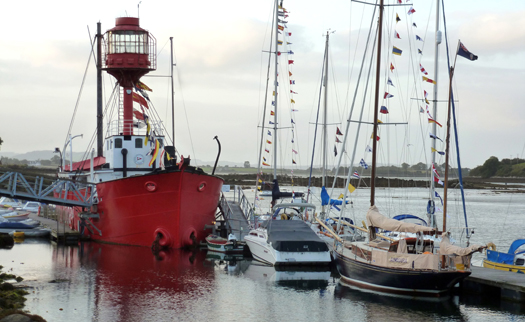
It's that old Dublin northside-southside thing transferred to Strangford Lough. The former lightship Petrel was built on the north side of the Liffey in 1912, while at the same time Ainmara was being built in Ringsend. Photo: WM Nixon
Because a lightship is built so specifically for one purpose, it has taken real vision to convert the Petrel into a charming club headquarters while retaining the spirit of the old ship. It has been done brilliantly, she's immaculately maintained, and this small club – they have less than 50 full members – is an impressive example for other organisations large and small, afloat and ashore.
So she provided the perfect setup to start the weekend with the Ainmara party. The weather obliged by coming in with one of those perfect Autumn evenings which is like summer only better, and folk turned up who had sailed on the old girl more than fifty years ago. Then next day it was Petrel's turn, with the Down Cruising Club members assembling more than half their total fleet in a sunflower raft out in the anchorage, followed by a barbecue on board ship which could have coped with any sort of weather conditions, as they've modified the after-deck to accommodate a very seamanlike marquee.
A vintage weekend. The Down Cruising Club do things their own way, so they have a President where other clubs might have an Admiral. In response to my suggestion that as they're going to be on the lightship for ever, it might be more appropriate to call their top honcho the Head Keeper, a very senior member pointed out that in addition to lightships, zoos have Head Keepers. But then as he surveyed the heaving throng in the hugely hospitable lightship bar, he added: "D'you know, you might just be right"
Summer in September
#sailing – Time was when mid-September saw sailing clubs making the final arrangements for their special end-of-season events, while boats based in the less-sheltered anchorages were already being hauled out to comply with insurance restrictions in face of the approaching equinoctial gales.
Most years, we don't get gales at the equinox. And strict scientific meteorologists like Evelyn tell us there's no such thing. But if there happens to be a big breeze of wind a week either side of September 21st, the rest of us still think it's the equinox in all its traditional power, so we cling to our superstitions.
In fact, the more conservative used to close in the limits even earlier. Down in Crosshaven, some old sages used to reckon you shouldn't have your boat west of the Old Head of Kinsale after August 15th. And up on Belfast Lough, it was once thought the height of folly to contemplate a cruise to the west coast of Scotland after the end of July.
But the upside-down summer of 2012 has knocked tradition even further astray. And much-improved harbours enable us to take advantage of a longer season. This is essential, for although sailing may struggle like other minority sports for its share of public attention, the annual programme grows by the year, and we'll look back at 2012 as a year in which the shoulders of the Irish season provided many of the highlights.
Of course the Olympics plumb in the middle of it all dictated the timing of other events. But you'd have been greeted with derision if you'd suggested to the sailors of two or three decades ago that late August 2012 would see a hugely successful Tall Ships Festival in Dublin, followed in September by the sun-filled, fun-filled visit to Dun Laoghaire of the utterly mind-blowing global sailing equivalent of Formuula One.
Then those sailors of yore would have declared you crazy if you asserted that, immediately afterwards, a week of racing for one of sailing holy grails - the Dragon Gold Cup - would get under way in Kinsale, for didn't you know boy, down towards the Old Head of Kinsale in mid-September, it's WINTER?
Admittedly the crack fleet of 60 International Dragons drawn from fleets worldwide racing at Kinsale have been experiencing quite rugged conditions, and at least one noted superstar, multi-talented legend Lawrie Smith, has seen a knee injury on Day One cramp his style.
Well, only slightly – he's right in there as a contender for the Cup. Yet he gets off the boat with crutches, so doubtless a parrot will be in place on the Smith shoulder by today. And they're rooting for him in West Cork – he lists his club as Glandore, where he has strong family holiday links going back to 1966.
The Dragon sailors would rather have a fresh breeze than a flat calm, and typically of this upside-down summer conditions are becoming warmer as the week progresses. At the sharp end of the fleet it's wide open with helms from half a dozen nations in contention, Long John Silver from Glandore among them.
THE MIGHTY MODS
As for the five MOD 70 trimarans which wowed the sailors of Ireland last weekend in Dublin Bay, they too have been finding the weather getting warmer, but then their course was south towards Cascais in Portugal after "a quick little loop" to take in the Fastnet Rock. Surprisingly, they'd smooth seas approaching northwest Spain, and good speeds above 20 knots, but once again the finish was a nail-biter in light airs, with Yann Guichard in Spindrift taking the win ahead of Foncia (Michel Desjoyeaux), and Oman (Sidney Gavignet) third. Overall, Spindrift leads by one point from Foncia, with Groupe Rothschild third.
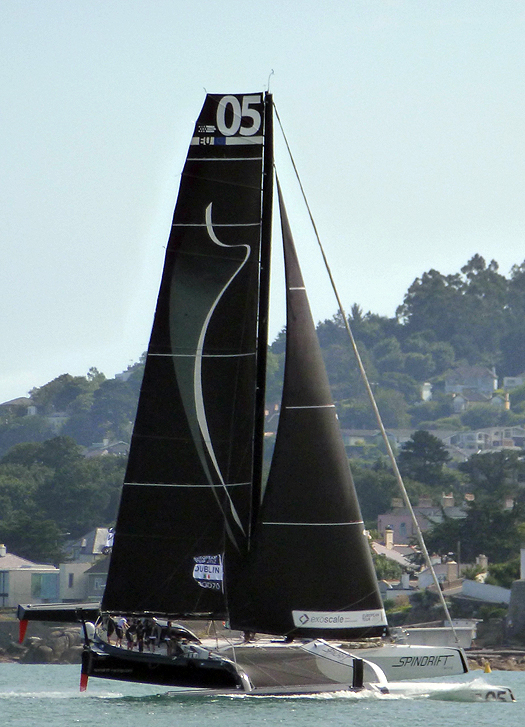
Current overall leader in Portugal Spindrift flies her main hull in Sandycove
So mind-blowing were the MOD 70s that we take a second look at them this week in the photo department. Because they're so completely enlarged versions of smaller cutting edge racers, at times you lose a sense of scale – their sheer size is not immediately evident. But then there's the noise of huge power being released as sheets are eased, and you're in no doubt about the massive loads involved in getting top performance out of boats which manage to weigh no more all-up than the total keel weight of a Volvo 70.
Everything about them is style, even if it's mistaken perception. See them blasting to windward in a good breeze, and the first impression is that the helmsman is right at the stern, hanging onto what seems to be a steering arrangement akin to the long handle-bars of a vintage Harley Davidson. Not so. That apparently godlike steersman is actually the humblest galley slave, the furthest-aft winch grinder – the helmsman is serenely removed from the slavery of the pit, out on the wing with one of the tillers to hand.
The boats look so different from various angles that, until you've seen them sailing, you might think you're looking at pictures of two or three different machines. From off the bow, they look like multihulls have looked for some decades now, but from abeam that chopped off stern gives them a harsh functionality worlds away from traditional notions of yacht design elegance.
We're told that to some extent the dreadnought bow with aft-raked stem is a fashion thing, but other designers say that it confers real advantage. You can expect to see rooster's tails of spume flying out astern of a Mod 70, but if there's any significant bow-wave showing, the chief designer will not be best pleased – a picturesque bow-wave really is a drag.
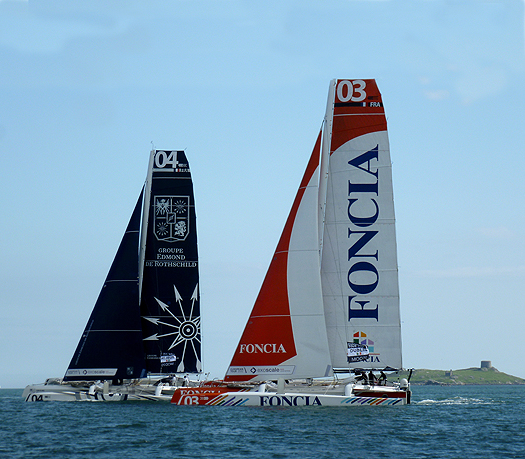
The MOD 70s have their own elegance
Handsome is as handsome does, and a MOD 70 in perfect trim at full chat can be as beautiful a boat as you can hope to see. But whether or not this extraordinary circus can be kept on the road remains to be seen. The hull-plug for the new Volvo 65 is well under way towards completion in Italy, so already the kind of international advertising money that goes into sailing at this level is being earmarked for the next edition of the Volvo.
Then too, the MOD 70s are totally a French show. Vive la France and all that, but Francophone dominance can be limiting, though the new boats certainly made a formidable impact in the US before the record-breaking Krys Transatlantic Race in July.
Well, we'll see. But meanwhile, we have seen. For those who had a hint of a notion of what they were looking at, the MOD 70s were simply fantastic. But whether or not Joe Public, ambling along the front or the pier at Dun Laoghaire and getting the occasional glimpse of incredible machines flashing by, was suitably impressed, is something else altogether.
CORK AT CONNACHTS NEAR CROKER
With Galway much in evidence at Croke Park last weekend, perhaps it was right and proper that the curious staging of the International Optimist Connacht Championship should take place just down the road on Broadmeadow Water at Malahide, but with 130 boats turning up, the young helms weren't going to let geographical nit-picking get in the way of sport. Cork dominated the results, flooding the lead places in all divisions, with Douglas Elmes winning the seniors and James McCann the juniors.
And last month in Howth, junior sailors in the 420 Nationals also saw Royal Cork setting the pace with a runaway win by Patrick Crosbie and Grattan Roberts. So already the bruising experiences of the Cork hopes in the Olympics can be put astern - there's a whole new wave of top talent coming along.
MOD70s Show Their Speed off Dun Laoghaire en Fête
#mod70–When Steve Fossett's 60ft trimaran Lakota came into Dun Laoghaire Harbour after setting a well nigh unbeatable Round Ireland record in September 1993, it was Dublin Bay's first introduction to the new generation of ultra-light speed machines, which were sweeping away long-standing time achievements by the fastest mono-hulls and the earlier waves of offshore multihulls.
Until this week, Lakota was our benchmark for the sharp end of multi-hull development. And she was a very good boat in her day. But as of midnight Wednesday, we're up to speed with the very latest thinking. The arrival of the five boats of the MOD 70 class at the end of Leg One of their European Tour has brought the awe-inspiring presence of machines which are 15 per cent bigger than Lakota, yet considerably lighter, and much faster.
That is, if they get the wind. Originally, the plan had been to race from Kiel out of the Baltic north of Scotland, then south to Dun Laoghaire. But the forecast – subsequently fulfilled – of gales in the high latitudes led to a re-routing through the English Channel. In this upside-down summer, they found precious little wind down south.

Manoeuvring for the start with a boat that seems as wide as it's requires special skills. Photo: WM Nixon
But as they're one designs, they'd brilliantly close racing. The lead changed several times, and the finish in the faintest zephyrs on Wednesday night just minutes before midnight saw the three front runners crawl across the line in just 77 seconds. That would be impressive in club racing. But in a 1300 mile offshore race, it's sensational.
Michel Desjoyeaux and his crew racing Foncia snatched it from Yann Guichard on Spindrift by 32 seconds, with Sebastian Josse and the Groupe Edmond de Rothschild team 45 seconds further back. Another 35 minutes elapsed before Steve Ravusin brought Race for Water to the finish. And then 1 hour and 34 minutes behind the leader, the fifth-placed Oman glided across in virtual calm, the crew including international multihull legend Brian Thompson who was with the late Steve Fossett – as were the National YC's Con Murphy and Cathy MacAleavey – when Lakota did the business 19 years ago.
When they went out for the first three City Races yesterday, hopes were high that the MOD 70s would get the kind of breezes in which they become truly spectacular, as the early afternoon gave a hint of a decent sea breeze filling from the southeast. But in early September, even when summer is doggedly clinging on, there just isn't the dynamic to create a fresh onshore wind, and though boats speeds of up to 14 knots were recorded in mid-afternoon, the winds were mostly light.
But it provided an ideal setup to observe these extraordinary machines in close-up, and for this reporter it was an excellent opportunity to tick several boxes at once, as we went to sea aboard Hal Sisk's remarkable 63ft "motor launch" Molly Bawn, an exquisite Nigel Irens design, built in Denmark, which is so easily driven in her elegant hull that they're able to measure fuel consumption by the litre.
So it was a dizzy combination, the sheer style of Molly Bawn, and the five MOD 50s zooming about with a deceptively relaxed air. A bit too relaxed in the case of Oman – they missed the first race through clobbering a rock with a daggerboard in Scotsman's Bay while being too enthusiastic about getting near the spectators on shore, though I think it was a little unkind of one non-sailor to comment that this was the most exciting thing that happened all afternoon.
By the time Oman re-joined for Race 2, Michael Desjoyeaux with Foncia was showing the sort of consistency which wins any boat racing series. These freakish machines, with hulls so narrow that the main crossbeam is actually thicker, really do race more or less like normal boats, which takes some skill in pre-start manoeuvres. But then, the sudden acceleration which results from getting the trim just right, means that massive gaps open out in seconds.
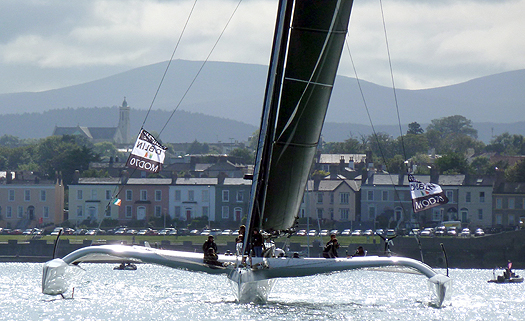
Weird and wonderful – a Mod 70's very slim main hull is narrower than the depth of the crossbeam. Photo: WM Nixon
Equally, of course, huge leads can disappear in a waft of wind. By the third race, Foncia was firmly in the points lead, and a new westerly drifting down the bay was indicated by the aroma of several happy barbecues ashore, not least at the National YC where hundred of happy punters were finding that this business of racing state of the art multihulls can be a notably thirst and hunger inducing affair.
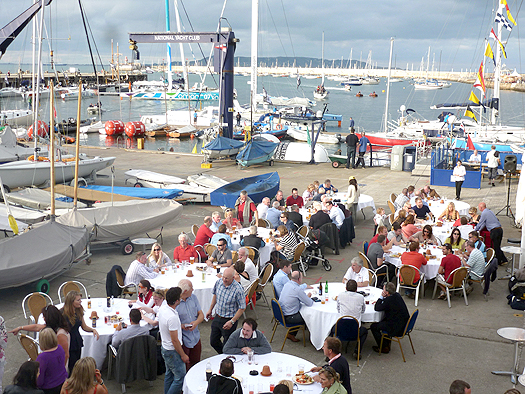
Apres sailing at the National YC – quite something for a September evening after the worst summer on record. Photo: WM Nixon
For a September evening after the worst summer on record, it was wuite something. Today, with Dun Laoghaire en fete, the five boats will be showing their exceptional speed potential with an afternoon of racing and speed trials from 2.0pm to 5.0 pm off Dun Laoghaire harbour and along the coast to Sandycove point. Then tomorrow afternoon it's back to serious work – Leg 2 of 1215 miles from Dun Laoghaire to Cascais in Portugal, with a good sou'wester in prospect.
While the MOD 70 circuit is the new sailing going very public indeed, down in Kinsale they're geared up for one of the classics of international sport, a week of racing for the Dragon Gold Cup which dates back to 1937. A remarkable fleet of 60 boats has converged on the south coast port, and with Simon Brien from Belfast Lough already putting down a marker by winning the class's historic Edinburgh Cup back in July, the thriving Irish fleet includes several favourites for the Gold.
Meanwhile both the 1720s and the Laser SB20 (formerly the Laser SB3) were showing they're in good heart with major championships last weekend, Mark Mansfield and Terry English of Crosshaven taking the 1720 Euros at Baltimore in the last race, while Ben Duncan of Howth emerged from the pack to win the SB20 Nationals.
This weekend at Malahide, we've a geographical conundrum. At its newly refurbished dinghy headquarters on the Broadmeadow, Malahide YC is hosting more than a hundred very junior helms in the International Optimist Connacht Championship. Is this inter-provincial confusion, or what? We're assured that Malahide is the Connacht of Howth, and geography can be stretched from there.
Barking Dogs And Spritely Centenarians
The dogs bark, but the caravan moves on. Most of us would probably have thought this was an item of pseudo philosophy which has been no nearer the sands of the desert than the beach at Tramore. But it will do for now to get the feeling of picking up the pieces and trying to focus on other things as we accept that the 2012 Sailing Olympics will not provide any sort of medal for Ireland.
It's harsh for the competitors, and agonizing for their fans. The dynamic between athletes and supporters has never been stronger, and with the event being held no further away from Dublin than West Cork, all involved could give it their best shot. Naturally we are now looking towards Rio. We were looking towards Rio before Weymouth. But the reality is that this year was the golden opportunity, in which resources could be maximized instead of being drained by the costs of campaigning on the other side of the world.
Those who would put the brightest spin on the results will tell us that the four years to Rio can be usefully employed in building on what were, by many standards, a solid set of results. Certainly there are countries much better resourced than Ireland which have been nowhere near the same placings this year. But how long can we hope to be building on good placings, instead of simply celebrating a medal or two?
At the personal level, four years is a very long time for the dedication required of Olympic hopefuls. Four long years, and out of a global population of billions, only three in each class get a medal at the end of it. You'd wonder about it. But then the athletes themselves reassert the Olympic spirit, and the show goes on.
Far indeed from the frenetic Olympics is the stately progress of the Tall Ships, and their arrival in Dublin in twelve days time will lift the mood of the sailing community. The traditional craft of the Old Gaffers Association will signal the start of the festival with a weekend gathering of ancient boats at Poolbeg Y&BC on the weekend of August 18th.
Meanwhile the renowned Ringsend boat designer and builder John B Kearney is being celebrated this week in Skerries with Mermaid Week – Skipper Kearney (1879-1967) designed the popular 17ft Mermaids 80 years ago. To mark this anniversary, Therese McHugh of Skerries, a former Mermaid Sailing Association chairman, organized the sailing of the Mermaid Thumbalina in coastal hops from the most westerly fleet at Foynes right round to Skerries.
Snippets about this remarkable voyage have appeared on Afloat.ie from time to time, and we hope to see the full account in due course. Ceratinly there has been an upsurge of interest in recent years in the work of John Breslin Kearney. He was a largely self-taught yacht designer whose day job was with Dublin Port & Docks, but in his spare time in 1911 he began building his first proper yacht, the 36ft yawl Ainmara, working in a corner of Murphy's Yard in Ringsend by the light of oil lamps, and no power.
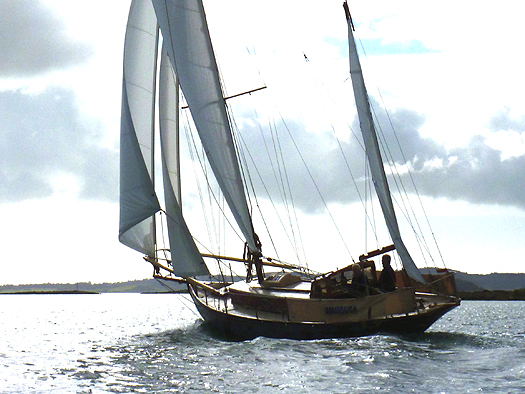
A place in the sun for Ainmara, the spritely Centenarian. Photo W M Nixon
Ainmara was launched in 1912, and since 1966 she has been owned by Dickie Gomes of Strangford Lough, who is best known for his racing skills aboard all sorts of racing machines – back in the day, he was a formidable multihull and maxi skipper, setting round Ireland records and winning the round Ireland race.
Truth be told, Ainmara languished for a while in a shed at Dickie's farm on the Ards Peninsula while he was doing his thing on the international scene. But he was determined to have her back afloat for her centenary this year, and she looks better than ever, a hundred years up and still going strong. Or at least I hope she's still going strong. By the time you read this, I'm supposed to be trundling round the Hebrides with Tiger Gomes on his spritely centenarian. He tells us she's making a drop o' tea, but that's allowed, it keeps her sweet.

For her Centenary this year, the J B Kearney designed and built Ainmara has been kitted out with a new suit of sails made by Mike Sanderson on Sketrick Island in Strangford Lough. Photo: W M Nixon
The Olympic Torch Visits the Howth Seventeens
#SAILING – With the Olympic torch burning its way through Ireland in ten days' time and the countdown to London 2012 well under way, the Irish squad for the sailing events in Weymouth has little enough time to adjust to its greatly increased size, with two new crews coming on board through last ditch qualifications.
The lonely selection voyage of Laser sailor James Espey of Ballyholme has finally reached a successful conclusion, and so too has the 470 campaign of Ger Owens of Dun Laoghaire and Scott Flanigan of Malahide. Malahide has always punched above its weight in the Olympic sailing stakes, and Flanigan carries the MYC flag along with Star class sailor David Burrows, while Ballyholme is also well in, as James Espey joins clubmates Ryan Seaton and Matt McGovern, who are already on board as Ireland's 49er crew.
For the latest additions, the turnaround from battling for selection to training for representation means that, as ISA Team Manager James O'Callaghan has put it, "there's work to be done between now and Weymouth". But in fact O'Callaghan's remark was primarily prompted by the somewhat erratic showing by the already-qualified Annalise Murphy in the recent Women's Laser Radial Worlds in Germany.
The weather was the most erratic feature of all, yet when the breeze was good Murphy was on top form, taking two wins and two seconds in the 133-boat fleet. But she also had a major upset with a collision, and the final day saw her logging a 33rd and 55th to drop nine places to 25th in fleet, not the sort of placing she's been used to in recent years.
But with a smaller fleet and (so they tell us) steadier breezes anticipated at Weymouth, she's on track for a good showing, as too are the Star class duo of Peter O'Leary and David Burrows, who ended as fourth overall in the recent worlds, very much in the frame.
There'll be a special link to sailing when the Olympic torch arrives at Olympic Council of Ireland HQ in Howth on June 6th, as Howth House, the OCI base, is the former home of the Boyd family of sailing folk, where Herbert Boyd designed the still-extant Howth Seventeen class.
The youthful Boyd utilised the spacious floor of the drawing room (where else?) to finalise the lines of his boat designs, and it was there in 1897 that he created the Howth Seventeen One Designs, which still look today exactly as he envisaged them 115 years ago.
Only a year earlier, the revival of the Olympics in their modern form had been achieved by Pierre de Coubertin. It's doubtful if Boyd ever had Olympic ambitions for his rugged little boats. But they are truly Olympian in their dogged persistence allied to timeless style with 115 years of solid sport, so there's no better place for the Olympic torch in Ireland.
But that's in ten days' time. Right now Howth is jumping with the 127-strong fleet battling it out in the three-day BMW Cruiser-Racer Nationals, and skippers of the calibre of current Sailor of the Year George Kenefick of Crosshaven at the helm of his Quarter Tonner "Tiger of Currabinny" (now there's a name to conjure with) are revelling in glorious early-summer weather.
Out in the Atlantic, however, the chances of mid-ocean calms are slowing arrival time hopes for the Volvo fleet (back on full strength) racing from Miami to Lisbon, with Franck Cammas and Damian Foxall and team on Groupama losing their early lead to Iker Martinez on Telefonica. The Atlantic weather is all over the place, and nerves will be well frayed before they get to Portugal.
W M Nixon's sailing column is in the Irish Independent on Saturdays
#SAILING – It will be coast-to-coast coverage for Galway sailing in late June, as global interest starts to focus on the western port city and the finish of the Volvo Ocean Race in early July, while the student sailors of Galway University are making a strong pitch for the Round Ireland Race starting from Wicklow on June 24th.
Their campaign is shaping up very well, as they've chartered Martin Breen's Reflex 38 which – as Galway Harbour – was overall winner of last year's main offshore event, the Dun Laoghaire-Dingle Race. The west coast sailing community have a good record in the biennial round Ireland, their most recent overall winner being Aodhan Fitzgerald skippering the First 40.7 Ireland West in 2008.
For this year's event, the status of the race has been up-graded – it now has the same standing in the RORC points championship as events of comparable length such as the Fastnet, and the Middle Sea Race. But in fact the 704-mile Round Ireland already has a special place among Europe's more discerning offshore sailors, and the current defending champion is Piet Vroon of the Netherlands with his Ker 46 Tonnere de Breskens.
Leading French offshore racing crews also like to record at least one bash at this classic circuit in their CVs, but as ever the bulk of the entries will come from Irish club sailors who see the Round Ireland as a rite of passage.
However, it is the west coast which has pioneered a new approach with this first university-based entry. The crew of 10, who represent many different areas of study and research in NUIG, will be skippered by Cathal Clarke, and already - despite the late arrival of some pleasant sailing weather - they have been actively training together on the boat.
Pat Morgan, Vice President of the Student Experience at NUI Galway, has voiced the University's active support for the challenge, which accords well with the college's approach to team-building skills and leadership development. The crew lineup is Cathal Clarke (skipper and trimmer), Ben Scallan & Eoghan McGregor (helmsmen), Joan Mulloy & Mark Armstrong (trimmers), Conor Kinsella & Ruaidhri de Faoite (mainsail trimmers), and Eoin Breen & Louis Mulloy (bowmen).
It's back into action for the Volvo Ocean Race boats this weekend at Itajai in Brazil, with the shore crews of damaged contenders working right down to the wire to be ready for today's in-port race. The International Jury have rejected a protest against the sails being carried by overall leader Telefonica, whose skipper Iker Martinez is keen to get on and get the programme completed, as he has recently confirmed that as soon as the Volvo is over in Galway, he is switching attention to becoming Spain's 49er helmsman in the Olympics just four weeks later – he won gold in 2004 and silver in 2008.
The narrowest window of repairs opportunity is being used by Ian Walker's Abu Dhabi, which has Ireland's Justin Slattery as bowman. Having been put aboard ship at Puerto Montt in Chile after sustaining structural damage in the murderous conditions racing across the Southern Ocean from New Zealand, the Walker boat Azzam was only offloaded in Brazil just two days ago. Amateur crews often use hair dryers to speed up the chemical curing of repairs to modern plastic construction, but even in sub-tropical Brazil, this job will have needed several industrial heaters.
W M Nixon's sailing column is in the Irish Independent on Saturdays
1720s and Mansfield Enjoy New Lease of Life
'The big man is back' reports WM Nixon this morning in the Irish Independent's Sailing Column. Reports of the demise of the 1720 are greatly exaggerated he concludes in a nice write up for the class and new champion, former Olympian Mark Mansfield here.







































































